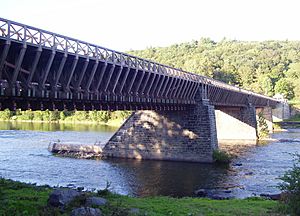Roebling's Delaware Aqueduct facts for kids
Quick facts for kids Roebling's Delaware Aqueduct |
|
|---|---|

The restored bridge, in 2011
|
|
| Carries | Motor vehicles, pedestrians |
| Crosses | Delaware River |
| Locale | Minisink Ford, New York to Lackawaxen, Pennsylvania |
| Other name(s) | Roebling Bridge |
| Maintained by | National Park Service |
| Characteristics | |
| Design | Suspension bridge |
| Total length | 535 feet (175 m) |
| History | |
| Opened | 1849 |
The Roebling's Delaware Aqueduct, also known as the Roebling Bridge, is a super old and important bridge in the United States. It's the oldest wire suspension bridge still standing! This amazing bridge stretches 535 feet (about 175 meters) across the Delaware River. It connects Minisink Ford, New York, to Lackawaxen, Pennsylvania.
When it first opened in 1849, it wasn't for cars or people. It was an aqueduct, which is like a bridge that carries water, specifically for the Delaware & Hudson Canal (D&H). Later, it was changed so that cars and people could use it.
Building the Roebling Bridge
Work on the Roebling Bridge began in 1847. It was one of four special aqueducts built for the D&H Canal. This canal was a big transportation system. It helped move coal from northeastern Pennsylvania to cities along the Hudson River. The canal first opened in 1828 and was made even bigger after the 1840s. It finally closed in 1898.
Two clever people, Russell F. Lord and John A. Roebling, designed this bridge. They also made sure it was built correctly.
There were two important jobs in the area that needed different things. These jobs led to the building of the Roebling's Delaware and Lackawaxen Aqueducts. One job was moving things on the canal. The other was floating logs down the river. Since the mid-1700s, logs from the Delaware valley were floated down to places like Trenton and Philadelphia.
The D&H Canal used a rope ferry to cross the Delaware River at Lackawaxen. This ferry caused problems. It slowed down canal traffic and often crashed into the log rafts floating downstream. To fix both these issues, the D&H Canal Company decided in 1846 to build two new aqueducts instead of the ferry.
Russell F. Lord looked at many ideas. He liked the designs from John A. Roebling the best. Roebling had already built a similar bridge in Pittsburgh in 1845. To make sure the canal was high enough for ice and river boats to pass underneath, Lord's plan included building three special locks on the eastern side.
The Delaware Aqueduct was a huge success right away. It cost about $41,750 to build. The Lackawaxen Aqueduct cost $18,650, but only its foundations are left today. These new bridges cut canal travel time by a whole day! This saved thousands of dollars every year.
From Canal to Car Traffic
After the canal closed in 1898, the aqueduct was emptied of water. It was then changed into a bridge for vehicles. Over time, the sides that held the canal water and the towpaths (walkways for people pulling barges) were taken off. The bridge was used as a toll bridge for wagons and later for cars until 1979.
Parts of the D&H Canal, including the Delaware Aqueduct, were named a National Historic Landmark in 1968. This means it's a very important historical place. The American Society of Civil Engineers also named the Delaware Aqueduct a National Civil Engineering Landmark. This shows how important its engineering design was.
The National Park Service bought the bridge in 1980. They used Roebling's original plans to rebuild the bridge's main structure in 1986. Then, in 1995, they rebuilt the wooden icebreakers, towpaths, and the walls that held the aqueduct's water. This made the bridge look just like it did when it was first built as an aqueduct! Today, the bridge is part of the Upper Delaware Scenic and Recreational River.
Images for kids






